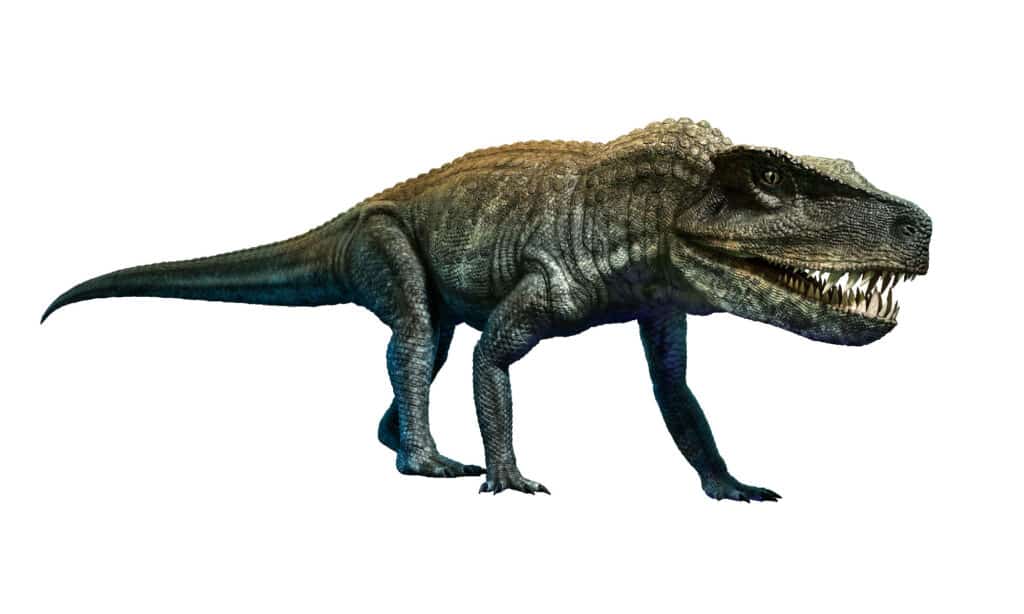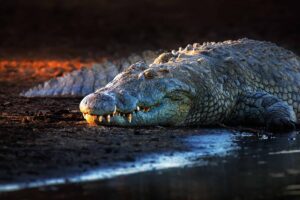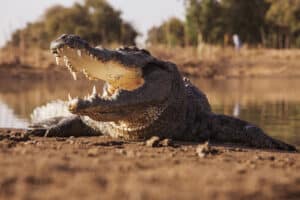Crocodiles have been around for a very long time. Even though they have gone through a lot of changes over the years, they seem to have figured something out all those millions of years ago with how successful they are. One of the ancient crocodiles of yesteryear was actually so scary that the people who found it named it the Chisel Crocodile! Let’s meet this 20-foot chisel crocodile and see what it’s all about.
Smilosuchus, the 20-foot Triassic crocodile

©iStock.com/Warpaintcobra
Smilosuchus is a 20-foot reptile that evolved during the Triassic Period million of years ago. Although they look extremely similar to crocodiles, they aren’t technically related. Smilosuchus was a long, semi-aquatic reptile that often grew more than 20 feet, making it an apex predator. It had the body shape of a crocodile, an elongated head and jaws, and a powerful tail used for swimming. They look so similar to crocodiles that the average person likely wouldn’t be able to differentiate the two if they saw them next to one another.
Smilosuchus is known as a phytosaur. Phytosaurs were a group of large, semi-aquatic reptiles that looked, acted, and lived just like modern crocodiles. It was believed that phytosaurs were the ancient ancestors of modern crocodiles and belonged to the Pseudosuchia group (the ancient split that resulted in today’s crocodiles), but further research shows that they aren’t closely related. When a species has similar traits to an unrelated species, this is known as convergent or parallel evolution. In the case of Smilosuchus and modern-day crocodilians, the convergent evolution is some of the clearest and most distinct.
Where did Smilosuchus get its name?
Smilosuchus’ name translates as “chisel crocodile” in English. A chisel is a tool used to chip material away in crafting, usually rock or wood. Chisels are sharp tools with a pointed end very similar to a knife. In fact, the translation of “chisel” is sometimes switched to “knife.” Some resources even refer to Smilosuchus as the “knife crocodile” instead.
Regardless of the usage of a knife or chisel, it’s clear that the name comes from the distinct tusks that Smilosuchus has. These tusks can be a few inches long and are located on the lower jaw near the front of the mouth. Either way, you wouldn’t have wanted to get caught by this powerful and deadly predator!
When did Smilosuchus live?
Smilosuchus lived during the Late Triassic period. Smilosuchus is actually a genus of related creatures, and each member of the Smilosuchus genus had its own distinct timeline. Scientists currently estimate that the entire group would have evolved and gone extinct between 221.5 and 205.6 million years ago. For reference, dinosaurs first evolved around 250 million years ago, although they aren’t technically classified as dinosaurs themselves.
The difference between Smilosuchus and crocodiles
One of the primary differences between Smilosuchus and modern crocodiles is their teeth. Smilosuchus, along with other phytosaurs, had teeth serrations like a shark. This tooth serration was unique in that it actually resembled a crack in the tooth. These cracks would have eventually spread as there was no evolutionary mechanism that allowed the Smilosuchus to stop their propagation.
Another difference between the two is their armor. Smilosuchus was much more heavily “armed” than modern crocodiles. This can be seen in the thick scutes (bony plates) on the skin of Smilosuchus, as well as the reinforced abdominal ribs.
Other differences include a more primitive ankle bone in Smilosuchus, nostrils located closer to the head, and a softer palate compared to the bony palate of modern crocs.
What sort of animals did Smilosuchus hunt?

When it comes to
Smilosuchus, data suggests it ate extremely large prey due to how large it was.
©iStock.com/CoreyFord
Using the scary teeth and bone structure as a guide, researchers know that phytosaurs, depending on their location, would have been either carnivorous, piscivorous (fish), or a combination. When it comes to Smilosuchus, data suggests it ate extremely large prey due to how large it was. One example of the kind of prey Smilosuchus would have eaten is Placerias. Placerias could have weighed up to 1.1 tons and had a body shape similar to a hippo.
Creatures similar to Smilosuchus
Smilosuchus isn’t a single creature but a genus of related animals. There are currently four members of Smilosuchus, including:
- Smilosuchus lithodendrorum
- Smilosuchus adamanensis
- Smilosuchus gregorii
There is some debate as to whether Smilosuchus is distinct from other Leptosuchus. Currently, it is considered separate, although that could change in the future.
Up Next:
- Crocodile Lifespan: How Long Do Crocodiles Live?
- See ‘Dominator’ – The Largest Crocodile In The World, And As Big As A Rhino
- Prehistoric Crocodiles: The Complete List of Ancient Crocodiles
The photo featured at the top of this post is © Kitti Kahotong/Shutterstock.com
Thank you for reading! Have some feedback for us? Contact the AZ Animals editorial team.






